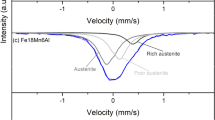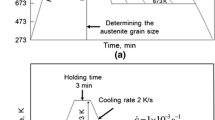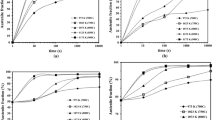Abstract
Low alloy steels serving for a long time at high temperature, e.g., around 500 °C, are very sensitive to temper embrittlement due to segregation of various trace elements at prior austenite grain boundaries and/or carbide/matrix interfaces. This type of segregation in combination with various environmental effects can adversely affect the fracture resistance and fatigue crack propagation rate with subsequent change in fracture morphology of low alloy steels. This article describes the segregation behavior of various elements in 2.25Cr-1Mo pressure vessel steel investigated by AES, FEG-STEM, SEM, and EDS analyses. As confirmed by AES and FEG-STEM, phosphorus is found to be the main embrittling element for isothermal embrittlement. Sulfur and Mo segregation is only evident after longer embrittlement times. In the step-cooling embrittlement, phosphorus is still found to be the main embrittling element, but heavy segregation of sulfur in some isolated intergranular facets was also observed. For P segregation, a Mo-C-P interaction is observed, while sulfur segregation is attributed to site competition between sulfur and carbon atoms.













Similar content being viewed by others
References
Islam M.A., Knott J.F., Bowen P. Critical Level of Intergranular Fracture to Affect the Toughness of Embrittled 2.25Cr-1Mo Steels. J. Mater. Eng. Perform. 2004, 13(5), 600-606
M.A. Islam, “Intergranular Fracture in 2.25Cr-1Mo Pressure Vessel Steel at Low Temperatures,” Ph.D. Thesis, The University of Birmingham, U.K., 2001
Islam M.A., Novovic M., Bowen P. Knott J.F. (2003) Effect of Phosphorus Segregation on Fracture Properties of 2.25Cr-1Mo Pressure Vessel Steel. J. Mater. Eng. Perform. 12(3), 244-248
Nishioka K., Knott J.F. (1990) Effects of Environment on the Occurrence of Intergranular Facets During Fatigue Crack Propagation in 9Cr-1Mo Steel. Mech. Engr. Publications, London, 241-254
Islam M.A., Bowen P., Knott J.F. (2005) Intergranular Fracture on Fatigue Fracture Surface of 2.25Cr-1Mo Steel at Room Temperature in Air. J. Mater. Eng. Perform. 14(1), 28-36
BS 7448 “Fracture Mechanics Toughness Tests, Part 1, Method for Determination of KIC, Critical CTOD and Critical J Values of Metallic Materials,” 1991, p 2677-2710
Naudin C., Frund J.M., Pineau A. Intergranular Fracture Stress and Phosphorus Grain Boundary Segregation of a Mn-Ni-Mo Steel. Scripta Mater. 1999, 40, 1013-1019
Yu J., McMahon C.J. Jr. (1980) Effect of Composition and Carbide Precipitation on Temper Embrittlement of 2.25Cr-1Mo Steel: Part 1. Effect of P and Sn. Met. Trans. 11A, 277-289
Thomson R.C., Miller M.K. (1998) Carbide Precipitation in Martensite During the Early Stages of Tempering in Cr-and-Mo-Containing Low Alloy Steels. Acta Mater. 46(6), 2203-2213
Wada M., Hosoi K., Nishiwaka O. (1982) FIM Observation of 2.25Cr-1Mo Steel. Acta Metall. 30, 1005-1011
Islam M.A., Knott J.F., Bowen P. Kinetics of Phosphorus Segregation and its Effect on Low Temperature Fracture Behaviour in 2.25Cr-1Mo Pressure Vessel Steel. J. Mater. Sci. Technol. 21(1), 76-84, 2005
Wada T., Hagel W.C. (1976) Effect of Trace Elements, Molybdenum and Intercritical HT on Temper Embrittlement of 2.25Cr-1Mo Steel. Met. Trans. A 7A, 1419-1426
Yu J., McMahon C.J. Jr. (1980) Effect of Composition and Carbide Precipitation on Temper Embrittlement of 2.25Cr-1Mo Steel: Part 2. Effect of Mn and Si. Met. Trans. 11A, 291-300
Briant C.L., Banerji S.K. (1979) Phosphorus Induced 350 °C Embrittlement in an Ultra High Strength Steel. Met. Trans. A 10, 123-131
Shin K.S., Tsao T. (1988) Effect of Carbon on Grain Boundary Segregation of Sulfur in Iron. Scripta Metall. 22, 585-588
Suzuki S., Obata M., Abiko K., Kimura H. (1983) Effect of Carbon on the Grain Boundary Segregation of P in Alpha-iron. Scripta Metall. 17, 1325-1328
Acknowledgments
The author is highly grateful to ORS Authority of U.K. and also Professor J.F. Knott and Professor P. Bowen of School of Metallurgy and Materials, University of Birmingham, U.K. to provide financial help during this research work. He also acknowledges Chris Hardy for her co-operation during AES analysis.
Author information
Authors and Affiliations
Corresponding author
Rights and permissions
About this article
Cite this article
Islam, M. Grain Boundary Segregation Behavior in 2.25Cr-1Mo Steel During Reversible Temper Embrittlement. J of Materi Eng and Perform 16, 73–79 (2007). https://doi.org/10.1007/s11665-006-9011-1
Published:
Issue Date:
DOI: https://doi.org/10.1007/s11665-006-9011-1




